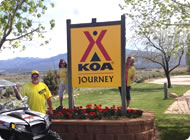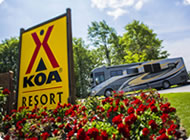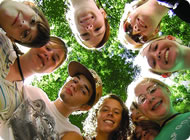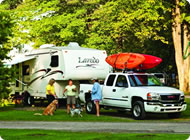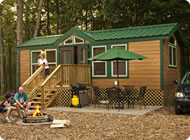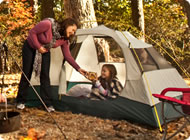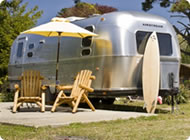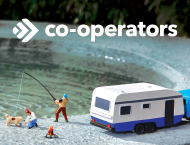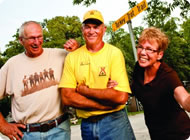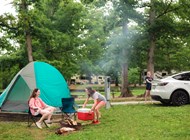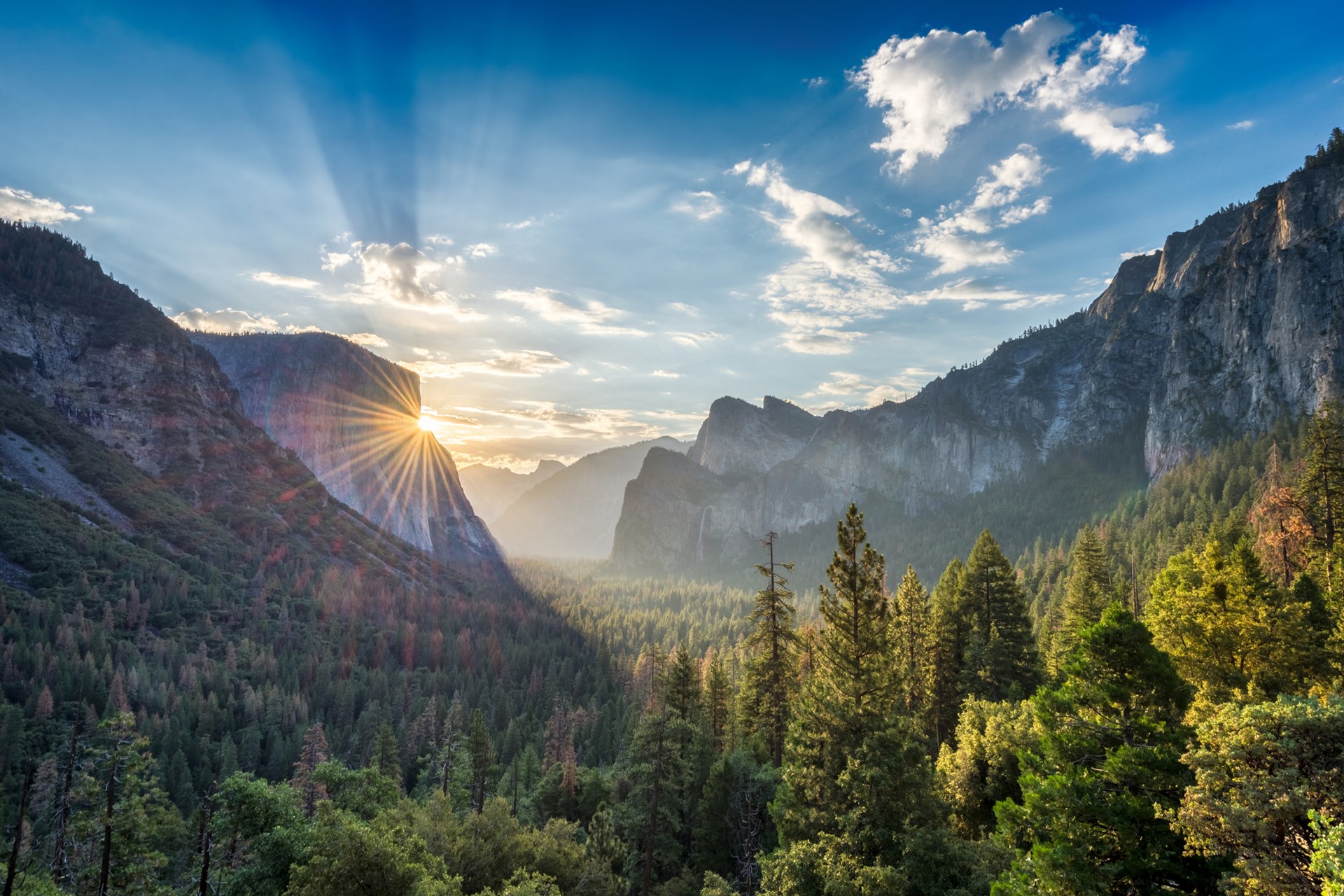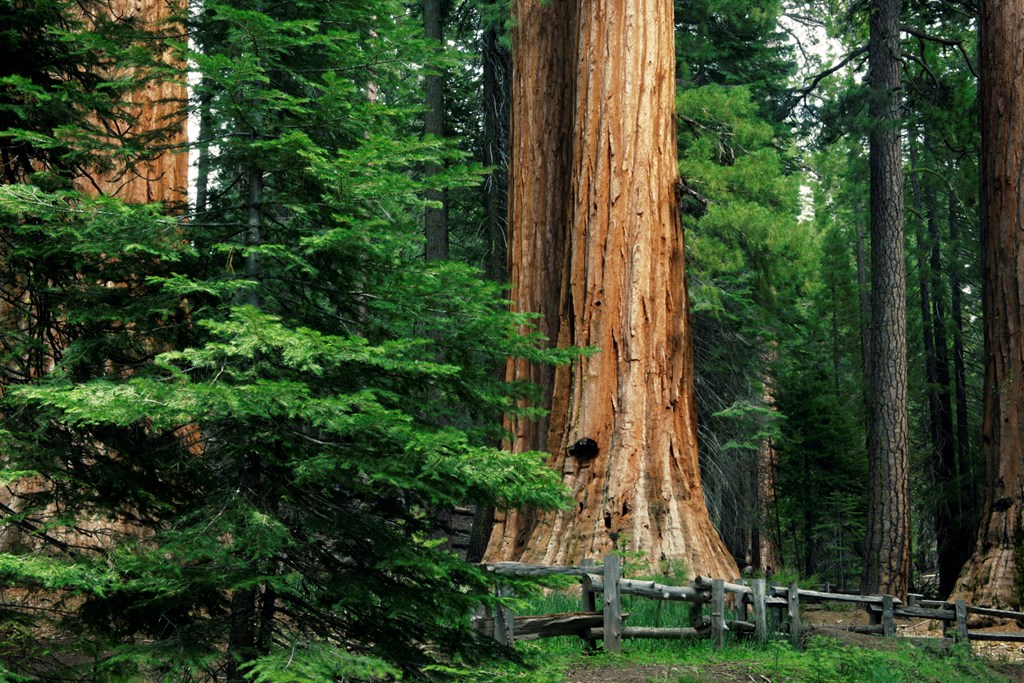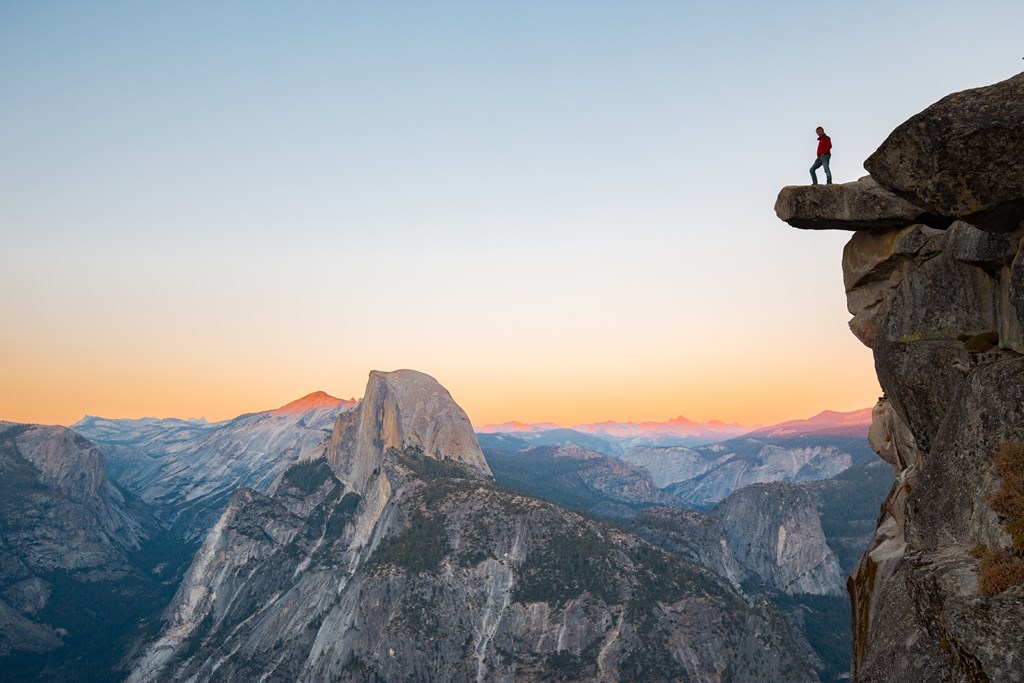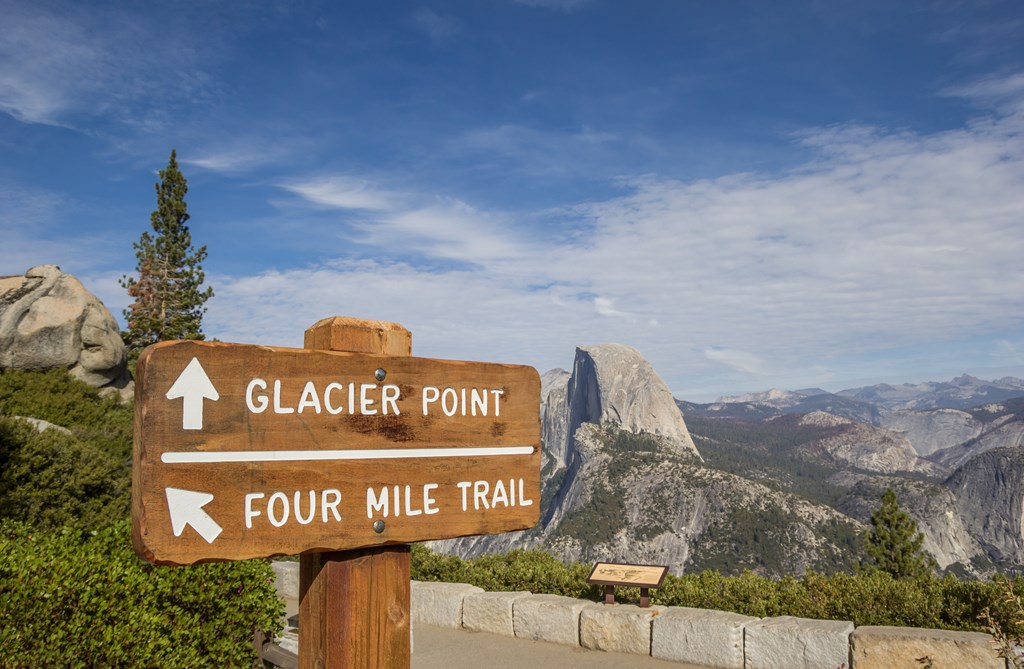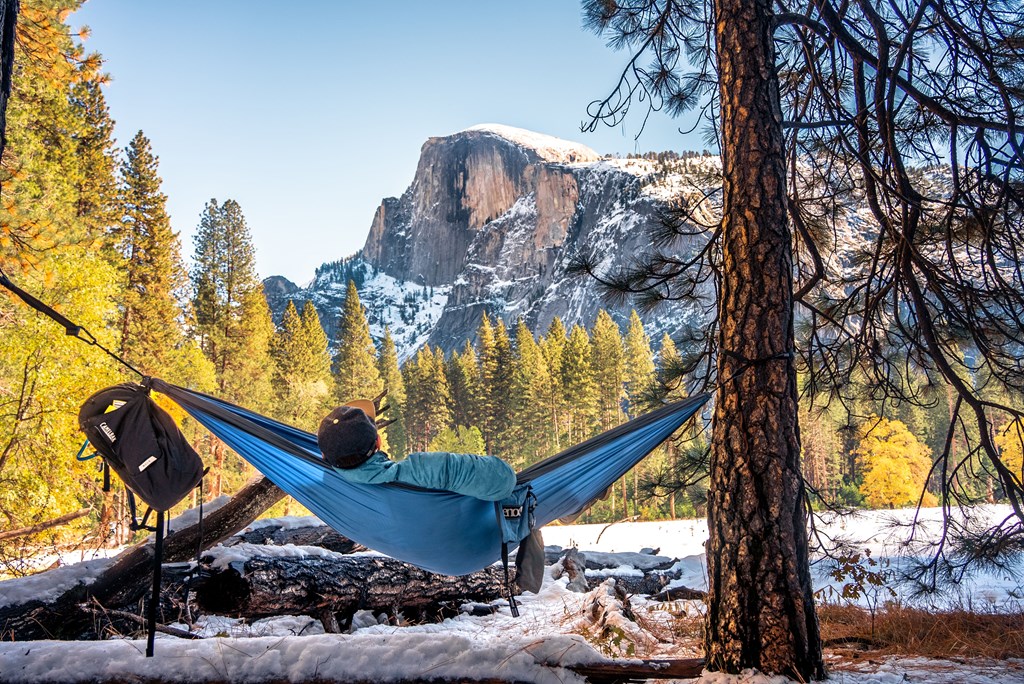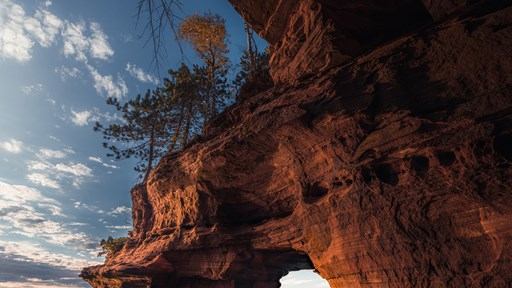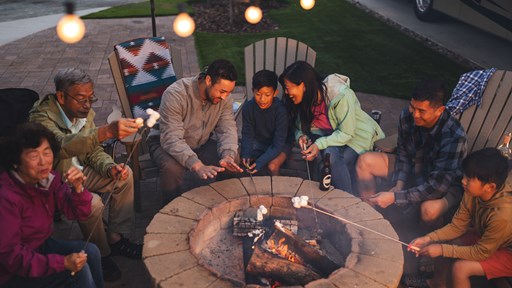Imagine a cathedral carved from granite, where sunlight streams through ancient sequoia groves. Picture waterfalls cascading down cliffs sculpted over millennia. That is Yosemite. Stand beneath the towering El Capitan, feel the mist of Yosemite Falls, and hike through meadows bursting with wildflowers. The raw beauty of Yosemite will leave you breathless. Stretching more than 1,200 square miles, it is a sanctuary for the soul, a playground for the adventurous and a reminder of the artistic power of nature.
If you want to experience the magic for yourself, this guide gives you all the inspiration you need. Choose from a three-, four-, and five-day itinerary for Yosemite National Park to make the most of every moment.
3-Day Yosemite Itinerary
Yosemite has so much to see and do that you would need more than three days to experience it all. That said, you can still squeeze a lot of wonder into a few days. Feel free to pick and choose how to spend your days for a mix of relaxation and activity.
Day 1: Yosemite Valley Highlights
Start your three-day itinerary in Yosemite National Park at its beating heart. Yosemite Valley is where you find some of the park’s most iconic waterfalls, towering cliffs and rolling meadows. Reaching the Valley means driving through the Wawona Tunnel, California’s longest highway tunnel. When you arrive on the other side, it is time to kick off your Yosemite journey:
- Take in Tunnel View: After driving through the Wawona Tunnel, take a moment to stop and appreciate the views. Expect to see Half Dome, El Capitan, Bridalveil Fall and Clouds Rest in the distance.
- Explore Yosemite Village: Pop in at the Visitor Center to find out about the conditions for your stay. One of the must-see things in Yosemite National Park is the Ansel Adams Gallery. Marvel at this prolific photographer’s collection of Yosemite works, then browse through the gift shop.
- Head to Lower Yosemite Fall: If you have a car, park near Yosemite Lodge Food Court. From here, it is an easy, flat hike to experience the majesty of Lower Yosemite Fall. The path can get busy during peak times, so get there early if you want to avoid the crowds. Be warned, you might get a refreshing blast from the waterfall’s mist!
- Cross to Cook’s Meadow Loop: Mosey across the road from Lower Yosemite Fall to the 1-mile Cook’s Meadow Loop. Stop to take in views of Half Dome, Yosemite Falls and the Valley.
- Enjoy the sunset at Taft Point: One of Yosemite’s best sunset views, Taft Point is a brief 2.2-mile hike starting at Glacier Point Road. The viewpoint overlooks Yosemite Valley and the awe-inspiring Fissures in the granite cliffs.
- Dinner at Yosemite Valley Lodge: Keep it simple with pizza, salads and noodles at Base Camp Eatery. For the more refined palate, the Mountain Room provides upscale fare with Yosemite Falls views to match.
If you are looking for a longer trail, you can also check out the Valley Loop Trail. This 11.5-mile trail is one of the park’s hidden gems. It offers a mostly flat path around the Valley’s walls, passing attractions like Pohono Bridge and Cathedral Rocks.
With day one of your itinerary for Yosemite National Park done and dusted, head off to bed for much-needed rest before tackling day two.
Day 2: Glacier Point and Mariposa Grove
To fit in a full day of exploring, get going early. Consider starting your day with breakfast at the Ahwahnee Dining Room. The historic location boasts magnificent architecture and serves a filling buffet. Non-guests can dine at the Awahnee, but be sure to make a reservation!
If you want to catch the sunrise at Glacier Point, take food along with you. You can reach the area by car or shuttle via Glacier Point Road, but the road is only open in summer. During the snowy season, you can access the Point by snowshoe or ski. The overlook is a quick hike from Glacier Point Road. You can also use it as a start or end point for the Four Mile or Panorama Trails. The summit rewards you with panoramic views of Yosemite Valley, El Capitan, Yosemite Falls and Half Dome.
After Glacier Point, head over to Mariposa Grove. You can park at the Welcome Plaza and take a shuttle to Mariposa Grove Trailhead or walk 2 miles to the trailhead if there are no shuttles. Choose one of the trails that take you through Mariposa Grove. The Grizzly Giant Trail and California Tunnel Tree are good options. Prepare for a humbling experience as you enter the heart of a forest of giant sequoia trees, some more than 3,000 years old!
Venture back to Mariposa Grove and stop in at the historic Wawona Hotel. Enjoy hearty cuisine served in a Victorian setting under hand-painted lamps. In summer, you can sit out on the veranda.
Day 3 (Summer): Exploring Tioga Road and Tuolumne Meadows
Traveling over the Valley on Tioga Road is a must in Yosemite National Park! The road is only open between late May and early June until November. Your adventure is a long one, so head out early and check out the following:
- Hike the Mist Trail: Trek to Vernal and Nevada Falls on the popular Mist Trail. The trail starts at Happy Isles Trailhead and earns its name from its proximity to the falls, so prepare to get wet! Climb stone steps over a footbridge and stop at Vernal Falls. You will pass the Emerald Pool and skirt Nevada Falls before reaching the hike’s summit. Then, either take the John Muir Trail for Nevada Falls and Liberty Cap views or head back on the Mist Trail.
- Grab a bite at Curry Village: For those who prefer to dine out, Curry Village offers an array of cafes and restaurants. From pizza to vegetarian options, you are sure to find something satisfying.
- Cruise along Tioga Road: The scenic drive along Tioga Road winds through mountain passes, connecting to the eastern side of Yosemite. Along the way, pause at Olmstead Point to take in Tenaya Lake, Clouds Rest and Half Dome. Once you reach Tenaya Lake, you can stop to cool off in the water or just enjoy the surroundings.
- Discover Tuolumne Meadows: Tuolumne is one of Sierra Nevada’s largest high-elevation meadows at 8,600 feet. Drink in the view of the Tuolumne River, surrounded by mountain peaks and domes. The area has a few hikes, including the May Lake or Cathedral Lakes trails.
- Dinner at Tuolumne Meadows Lodge: Finish your final day with dinner in a tent beside the river. Alternatively, head back to your camp.
Day 3 (Winter): Alternatives to Tioga Road
Yosemite still offers plenty to see when visiting in the cooler months. For visits outside of summer, start your day on the Mist Trail and then head to Bridalveil Falls. The hike starts at the Bridalveil parking lot, a quick drive from Vernal Falls. This easy 0.5-mile trail is open all year and takes around 20 minutes to complete. Bridalveil gets its name from its lacy, delicate cascades resembling a bridal veil.
Following the Bridalveil hike, you can either catch the sunset at Tunnel View or head back to your camp. As day three draws to a close, you can rest easy knowing you have crammed a lot of memories into a few days.
4-Day Yosemite Itinerary
A four-day itinerary in Yosemite National Park gives you much-needed extra time to experience more of the park. For the first and second days, you can follow the three-day itinerary or mix and match as you see fit. Here are a few options for days three and four of your adventure.
Day 3: Harder Hikes for Seasoned Pros
If you are a seasoned hiker who enjoys a challenge, you can try one of Yosemite’s more strenuous hikes:
- Half Dome: You must get a permit to hike the Dome. Permits work on a lottery basis. Try getting them in the March preseason lottery, which starts on March 1. You can also try your luck at the daily lotteries two days before your trip. This 14- to 16-mile hike is not for the faint of heart, but if you manage it, the breathtaking views are worth it!
- Upper Yosemite Falls: If you feel brave, you can tackle the 7.6-mile trip to Upper Yosemite Falls, also known as North America’s tallest waterfall. A warning! The hike to Upper Yosemite Falls takes a full day and involves a steep uphill climb.
Day 4: Mirror Lake and Spectacular Views
Spend the final day of your trip enjoying some of Yosemite’s natural masterpieces. Nature photographers love Mirror Lake for its stunning scenery. This hike will take around an hour to the lake and back or up to three hours if you do a full loop around the lake. The best time to visit the lake is in late summer and early spring, when it offers a picture-perfect reflection. At other times of the year, it transforms into Mirror Meadow.
If you are visiting Yosemite in the warmer months, the park offers plenty of scenic areas to take a refreshing dip, such as Tenaya Lake, Sentinel Beach or the Merced River. After your swim — and if Glacier Road is open — head to Washburn Point for views of Half Dome, Mount Broderick and Liberty Cap.
Finish your day by watching the sunset at Sentinel Dome. Starting at the Taft Point Trailhead, hike a short 2.2 miles for unbelievable views. Take a picnic to enjoy your dinner with El Capitan, Yosemite Valley, Half Dome and waterfalls as the backdrop.
5-Day Yosemite Itinerary
Five days in Yosemite gives you plenty of time to enjoy all the park has to offer, with time for relaxation. Build on the itineraries for days one to four above and add in one — or a few — of the following.
Explore the Hetch Hetchy Valley
Discover a lesser-known gem in Yosemite’s northwest corner! The Hetch Hetchy Valley offers delights throughout the year, with towering falls in spring and snowy cliffs in winter. You can only get to the area by car. Travel around 38 miles from Yosemite Valley on Highway 120 to the Big Oak Flat Entrance Station. Once there, you can hike to the waterfalls or investigate the wilderness.
Wander to Wapama Falls
For waterfall enthusiasts, the Wapama Falls Trail provides a Mist Trail experience but with fewer crowds. The falls are a quick hike across the Hetch Hetchy dam, through a tunnel and along the reservoir. A warning — you will definitely get wet when you cross the bridges below the falls! Think of it as a refreshing shower or, at the very least, a good story to tell. Keep an eye on the spray. If it seems too dramatic, you may want to witness the falls from a distance.
Milkshakes and Relaxation
End your fifth day with a milkshake or smoothie at Camp Mather General Store, close to Wapama Falls. Then, take part in camp activities, unwind in one of the park’s scenic spots, or just take it easy. Rest and relaxation are the perfect way to wrap up a jam-packed Yosemite itinerary!
Yosemite National Park Things to Do
Besides its iconic landmarks, awe-inspiring scenery and hiking trails, Yosemite offers many activities. One thing is for sure — you will never get bored! Here are some things to do in and around the park:
- Adventure activities: For a different way of experiencing Yosemite’s majesty, try mountain biking, rafting, horseback riding or rock climbing. Adrenaline junkies can view the park from the air by skydiving! Are you a snowbird? Enjoy one of Yosemite’s winter activities, like cross-country skiing or ice skating.
- Arts and culture: Yosemite provides plenty of artistic inspiration. Browse the local galleries and museums, or take part in a summer art workshop to create your own masterpiece.
- Wawona Golf Course: If your clubs accompany you to Yosemite, play a few rounds at the regulation Wawona Golf Course. Located across from the iconic Wawona Hotel, this nine-hole course challenges and rewards.
- Fishing: From lakes to mountain streams, Yosemite has a range of picturesque fishing spots. You need a California sport fishing license to fish in the park, which is a bait fishing-free zone. Before casting your line, familiarize yourself with the regulations. For example, there is a catch-and-release policy for Merced River rainbow trout.
- Recreation: Mariposa County has something for the whole family! Pan for gold, relax at a spa, indulge in some shopping or visit the nearby Splash-n-Dash Aqua Park.
Where to Stay Near Yosemite National Park
For a true Yosemite experience, consider camping. Whether in an RV, tent or cabin, a campground lets you connect to the wonder of nature. Kampgrounds of America offers modern amenities — every KOA campground has laundry facilities, playgrounds, clean bathrooms with hot water, and KOA stores where you can buy your essentials. Enhance your Yosemite National Park camping itinerary by staying at a quality, convenient campground.
The Coleville / Walker KOA Holiday is an ideal base to explore the Eastern Sierra. Amenities include a swimming pool, game room, Wi-Fi, group campfires and a KampK9® dog park for your furry friends. KOA offers Tent Sites, RV Sites and Camping Cabins, so you can camp the way you like!
Yosemite National Park FAQs
A trip to Yosemite is a once-in-a-lifetime adventure. To make the most of your visit, here are answers to some of the most-asked questions:
When Is the Best Time of the Year to Visit Yosemite?
The best time to go to Yosemite depends on what you want to get out of it. Do you want to experience the waterfalls in full flow? Are fewer crowds more your thing? These guidelines can help you pick the perfect time to visit:
- Go in spring for peak waterfall season: During spring, Yosemite’s waterfalls put on a dazzling show, fuelled by snowmelt. Areas like Glacier Point and Tioga Road also open in late spring, but be sure to check this ahead of your trip.
- Visit in summer for full access: From July to September, all areas of the park are open. Experience Glacier Point, Tioga Road and Tuolumne Meadows, as well as the Half Dome hike. Summer is peak season at Yosemite, so expect crowds. Temperatures can also soar during the hotter months.
- Consider fall for fewer crowds: The changing leaves bring a special kind of charm to the park. Fall offers a more relaxed, quieter experience. While you can head to Tioga Road and Glacier Point until snow starts falling, some services close toward the end of October.
- Indulge in winter wonder: For those who enjoy snow activities and cost savings, winter may be ideal. Glacier Point and Tioga Road close during winter, but there is plenty to do and see. From skiing to winter hikes, you can still make memories in the chilly season. Prepare for road closures and trickier driving conditions. You may need snow chains to navigate roads inside or outside the park.
How Many Days Should You Spend at Yosemite?
While there is no specific number of days, between two and four should give you enough time to experience the things at the top of your list. Five days allows you to explore the area fully, including hidden treasures like Hetch Hetchy.
Do You Need a Reservation to Visit Yosemite?
Each year, Yosemite publishes a vehicle reservation system. Check the National Park Service website to understand entrance reservations before your trip. The park does charge entry fees for vehicles. If you visit National Parks often, consider investing in an annual America the Beautiful National Park Pass, which can save money.
You may need to make reservations in February during Yosemite Firefall. The phenomenon, where the setting sun makes Horsetail Fall appear as if on fire, draws hundreds of visitors. On weekends in February, all visitors need a permit to enter the park.
How Do You Get to and Around Yosemite?
Hiking is a great way to experience Yosemite, but you will need a car to get around its 1,200 square miles. The Yosemite Valley area has free shuttles operating from 7 a.m. to 10 p.m. daily. Hop on the green route to traverse the Valley or the purple route for Yosemite and Curry Villages. An important note — the shuttles travel on a one-way loop. So, if you get on at stop 10 and want to get off at stop 9, you will need to travel the entire route.
Make the Most of Your Yosemite Camping Itinerary When You Camp at KOA
A trip to Yosemite National Park opens your eyes to the majesty of nature. Staying at a campground is the perfect way to enjoy the park and the natural landscape around you. Planning the ultimate camper’s itinerary to Yosemite National Park? KOA is passionate about creating unforgettable camping experiences.
At KOA, the amenities, flexible campsite options and recreational activities offer something for everyone. Connect to the world and people around you. Stay at a KOA Campground near Yosemite and discover a better way to experience National Parks!
About the Author: Kampgrounds of America
Kampgrounds of America is the largest system of open-to-the-public campgrounds in the world, with over 500 locations across the United States and Canada. Founded in Billings, MT in 1962, KOA’s family of campground brands – KOA Journey, KOA Holiday and KOA Resort – today serve more than a million camping families each year. KOA is dedicated to “connecting people to the outdoors and each other” by providing people with a variety of camping experiences and the information they need to make the most of their camping trip. Read more of their camping and travel resources by visiting KOA.com/blog.





